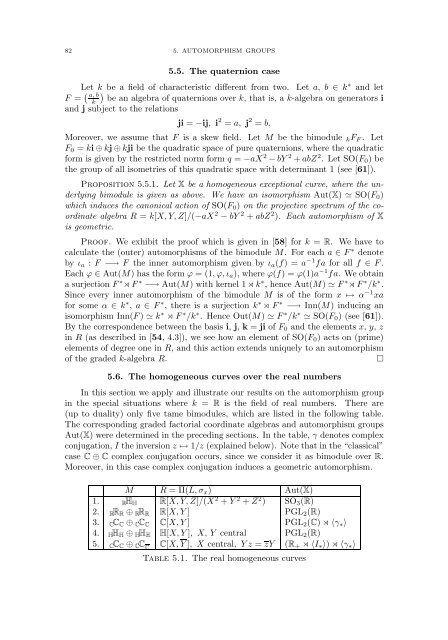MEMOIRS
MEMOIRS
MEMOIRS
- No tags were found...
Create successful ePaper yourself
Turn your PDF publications into a flip-book with our unique Google optimized e-Paper software.
82 5. AUTOMORPHISM GROUPS5.5. The quaternion caseLet k be a field of characteristic different from two. Let a, b ∈ k ∗ and letF = ( )a, bk be an algebra of quaternions over k, thatis,ak-algebra on generators iand j subject to the relationsji = −ij, i 2 = a, j 2 = b.Moreover, we assume that F is a skew field. Let M be the bimodule k F F . LetF 0 = ki ⊕ kj ⊕ kji be the quadratic space of pure quaternions, where the quadraticform is given by the restricted norm form q = −aX 2 − bY 2 + abZ 2 .LetSO(F 0 )bethe group of all isometries of this quadratic space with determinant 1 (see [61]).Proposition 5.5.1. Let X be a homogeneous exceptional curve, where the underlyingbimodule is given as above. We have an isomorphism Aut(X) ≃ SO(F 0 )which induces the canonical action of SO(F 0 ) on the projective spectrum of the coordinatealgebra R = k[X, Y, Z]/(−aX 2 − bY 2 + abZ 2 ). Each automorphism of Xis geometric.Proof. We exhibit the proof which is given in [58] fork = R. We have tocalculate the (outer) automorphisms of the bimodule M. For each a ∈ F ∗ denoteby ι a : F −→ F the inner automorphism given by ι a (f) =a −1 fa for all f ∈ F .Each ϕ ∈ Aut(M) has the form ϕ =(1,ϕ,ι a ), where ϕ(f) =ϕ(1)a −1 fa.Weobtaina surjection F ∗ ⋊ F ∗ −→ Aut(M) withkernel1⋊ k ∗ , hence Aut(M) ≃ F ∗ ⋊ F ∗ /k ∗ .Since every inner automorphism of the bimodule M is of the form x ↦→ α −1 xafor some α ∈ k ∗ , a ∈ F ∗ , there is a surjection k ∗ ⋊ F ∗ −→ Inn(M) inducing anisomorphism Inn(F ) ≃ k ∗ ⋊ F ∗ /k ∗ . Hence Out(M) ≃ F ∗ /k ∗ ≃ SO(F 0 )(see[61]).By the correspondence between the basis i, j, k = ji of F 0 and the elements x, y, zin R (as described in [54, 4.3]), we see how an element of SO(F 0 ) acts on (prime)elements of degree one in R, and this action extends uniquely to an automorphismof the graded k-algebra R.□5.6. The homogeneous curves over the real numbersIn this section we apply and illustrate our results on the automorphism groupin the special situations where k = R is the field of real numbers. There are(up to duality) only five tame bimodules, which are listed in the following table.The corresponding graded factorial coordinate algebras and automorphism groupsAut(X) were determined in the preceding sections. In the table, γ denotes complexconjugation, I the inversion z ↦→ 1/z (explained below). Note that in the “classical”case C ⊕ C complex conjugation occurs, since we consider it as bimodule over R.Moreover, in this case complex conjugation induces a geometric automorphism.M R =Π(L, σ x ) Aut(X)1. RH H R[X, Y, Z]/(X 2 + Y 2 + Z 2 ) SO 3 (R)2. RR R ⊕ R R R R[X, Y ] PGL 2 (R)3. CC C ⊕ C C C C[X, Y ] PGL 2 (C) ⋊ 〈γ ∗ 〉4. HH H ⊕ H H H H[X, Y ], X,Ycentral PGL 2 (R)5. CC C ⊕ C C CC[X, Y ], X central, Yz= zY (R + ⋊ 〈I ∗ 〉) ⋊ 〈γ ∗ 〉Table 5.1. The real homogeneous curves
















